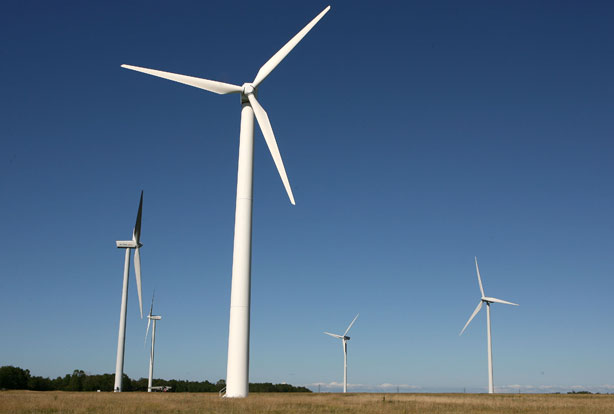
TORONTO – Ontario residents could end up paying some of the highest costs for electricity in the developing world because providing wind and solar energy will cost about 40 per cent more than government estimates, according to a new study.
Ratepayers should expect their electricity bills to rise by 65 per cent by 2015 and 141 per cent by 2030 – substantially more than current government predictions of 46 per cent and 100 per cent, the study found.
The average residential user’s annual bill, which currently stands at $1,700, will exceed $2,800 by 2015 and be over $4,100 by 2030, it predicts.
Certain costs weren’t included in the government’s estimates, such as inflation, transmitting electricity to the provincial grid from wind and solar facilities and backup generation for potential disruptions, the study found.
Those higher costs would erode the competitiveness of businesses in Ontario and pose challenges for low-income households, said University of Guelph professor and agricultural economist Glenn Fox, who co-authored the study with retired banker Parker Gallant.
Bills could climb even higher because the study didn’t include other potential costs, such as possible cost overruns as the province refurbishes its nuclear fleet.
The study said it found a number of omitted costs that weren’t included in Ontario’s long-term energy plan, which was released last year by the governing Liberals.
The plan underestimates the capital costs of wind turbines, for example, and fails to attach any individual dollar values to specific transmission projects to put renewable energy projects on the provincial grid, the study said.
The plan also lowballs the costs of backing up renewable energy with natural gas-fired plants when the wind isn’t blowing and the sun isn’t shining, saying it will cost $1.8 billion when it will likely be closer to $9.6 billion.

Get breaking National news
Energy Minister Brad Duguid called the study “bogus,” saying it’s full of technical errors and incorrect assumptions. He also took aim at its authors, saying Gallant is known for opposing renewable power.
“It’s not an honest study,” Duguid said in an interview.
“There are a number of areas in there that they’ve miscalculated – probably deliberately – but certainly the conclusions they’ve reached are simply incorrect and bogus.”
Gallant said he started examining the energy sector after receiving an “ugly” electricity bill, but stands by the study’s findings.
And rates are going up. The Ontario Energy Board announced Monday that residents using smart meters will see their bills increase 1.8 per cent starting in November, representing an extra $2.11 on the “electricity” line.
Gallant and Fox’s study also concluded that the government’s push for green energy is affecting the province’s finances as well.
Due to the costs of connecting renewables to the provincial grid, Hydro One has reduced its dividend payments to the province, affecting the government’s ability to reduce a provincial debt that currently stands at $230 billion.
Between 2004 and 2008, Hydro One’s average dividend payment to the province was 64 per cent of earnings. In the first nine months of 2010, it was down to less than five per cent, the study said.
Ontario Power Generation, which was excluded from wind and solar projects, will lose revenue because those projects are put at the front of the line when accessing the provincial grid, the study said.
That means it will take longer for OPG to repay the stranded debt that was created when the former Ontario Hydro was split into three different entities, it said.
One of the largest hidden costs involves local distribution companies, who can apply for a rate increase if their revenues deteriorate due to energy conservation efforts and “the shortfall will be charged to ratepayers,” the study said.
It also casts doubt on Liberal claims that the Green Energy Act will create 50,000 new jobs.
Premier Dalton McGuinty often touted those job-creation claims during the Oct. 6 election campaign, making frequent stops at plants that manufacture wind and solar power components as he travelled the province.
How the government arrived at that number “has never been explained,” the study said. And creating those 50,000 new green energy jobs will require ratepayer subsidies of about $200,000 a year for each position.
“That’s a lot of money, and how many other jobs could have been created if we hadn’t increased taxes to pay for it,” said Progressive Conservative Leader Tim Hudak.
Hudak promised during the campaign to tear up key sections of the Liberals’ green energy policy, but failed to topple McGuinty, who returned to office with a reduced mandate of 53 seats – one short of a majority government.
“At the very least with this new government situation, let’s shine the light, let’s have transparency on how much this costs and how many contracts are actually out there, and what it’s going to mean for the average family,” Hudak said Monday.
The Liberals have been downplaying the costs of their energy plan, but the study takes aim at the wrong target, said New Democrat Peter Tabuns.
“This report goes after green energy, when we think the biggest cost risks are nuclear power and the profiteering that’s going on,” he said.
“If we want affordability, we need more public ownership, more conservation and frankly, more renewable power.”
The study, which is currently available online, is slated to appear in an upcoming issue of Bulletin of Science, Technology and Society.








Comments